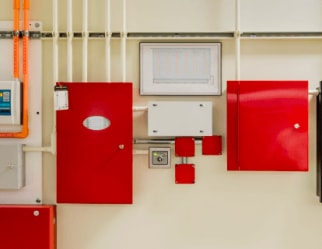Choosing the right low-voltage cables ensures that your network, telecommunication and security system cable installations comply with relevant safety standards where necessary and offer the correct performance requirements for a particular application to avoid potential problems down the road. Because cable ratings and substitutions involve several factors, depending on the application, there are considerations when choosing cable for your next project.
What are the Construction Product Regulations (CPR) requirements for data cables?
Construction products refer to anything incorporated into the structure of a building, including cables. The 2017 Construction Products Regulation (CPR) ruled that all cables intended for permanent installation within domestic, residential and commercial buildings are subject to the Construction Products Regulation (CPR) and carry both a CE (UKCA for the UK) mark and have a Declaration of Performance (DoP) declaring a CPR Euroclass Fire Performance Rating.
The six Euroclasses are shown below. To get a Euroclass cables must be independently tested to BS EN 50399 and BS EN 60332-1-2 to evaluate fire performance factors like resistance to spread, smoke production, smoke acidity and production of flaming droplets. The seventh Euroclass, Fca, effectively means that the cable has not been tested.
Although the regulations and the Euroclasses below are the same across Europe the choice of how to implement the requirements has been left to each individual country. In the UK there is no legal requirement for particular Euroclasses to be used in particular applications. Instead it is up to the designer, specifier or installer to satisfy themselves that the cables chosen are appropriate for the application and meet any contractual requirements. So it is important to note that at the moment, any CPR-classified cable can be used, whatever their Euroclass, providing that they are contractually acceptable.
In EU Member States, governments have generally been more prescriptive and have defined minimum CPR Euroclass ratings for different applications, with B2ca,s1,d1,a1 required for escape routes and for high-risk buildings such as hospitals or high-rise buildings with large numbers of occupants. For lower risk buildings and area a lower class such as Dca or Eca may be acceptable.
What are the implications for installers and specifiers?
In the wiring regulations, BS7671 guidance on CPR is to consult BS6701:2016+A1:2017. In this publication, it’s recommended that data cables intended for permanent installation behind walls, above ceilings, or below floors – or where access to them is limited, meet a minimum requirement of Cca s1b, d2, a2. This applies to cable installations in new build projects, refurbishments and extension of existing buildings.
Because the cabling infrastructure is governed by BS7671, the decision on the cabling to be used must be made during the design phase and ultimately approved by the client – not the installer.
Although the minimum recommended standard in BS6701+A1:2017 has been deemed as being Cca-s1b,d2,a2, for some projects, such as prisons, hospitals, schools, airports and hotels, consultants will specify the higher graded B2ca cables because their contribution to the fire is very low.
Mindful of the options and the fact that Category 5e is already no longer the ‘minimum cabling standard’ for office installations in the US and International standards, ADI has addressed the market with the cable options, including, Category 5e LSOH U/UTP Cca sheath in green, Category 6 LSOH U/UTP B2ca sheath in orange, Category 6a LSOH U/FTP B2ca sheath in orange plus a range of Fibre Optic Cables
How can I compete using CPR-compliant cabling when my competitors do not, and how much more does it cost?
To compete using CPR-compliant cabling when your competitors do not, it's important to consider the cost implications and the value proposition for your clients. While CPR-compliant cables may be slightly more expensive, the overall impact on project costs is relatively small.
For example, let's assume you're bidding on a CCTV project with 30 cameras and an average cable distance of 30 meters, requiring a Category 6 cabling system. Using CPR-compliant cable may cost less than £5 per camera more than the traditional low smoke zero halogen or PVC cable. The overall percentage increase is minimal when you factor in the other project expenses, such as connectivity, cameras, equipment, and installation.
However, how does one compete effectively without sacrificing margin? By offering CPR-compliant cabling, you ensure that you meet the latest recommendations and standards, providing peace of mind to your clients. This also prevents any potential issues where you might have to replace non-compliant cabling in the future, which could be costly.
Educating your customers about the benefits of CPR-compliant cabling is another strategy to counter bids from competitors using non-compliant alternatives. Highlight the fact that your cabling is fully standards-compliant, ensuring fire safety regulations are met. Additionally, inform them that some insurance companies offer incentives or reduced premiums to building owners with CPR-compliant cabling.
Furthermore, you can provide multiple options to your clients. Explain that they can choose between cabling to the previous standards (such as the purple LSOH) or adopting the new CPR-compliant standards. Ensure they understand the implications of choosing an outdated standard, particularly regarding health and safety. When informed about the potential risks, most clients opt for up-to-date standards.
Ultimately, the responsibility lies with the client to make an informed decision. By presenting them with the facts and benefits of CPR-compliant cabling, you increase their chances of choosing the safer and more reliable option.
If you need help choosing low-voltage cable for your next project, contact our Systems Design team.




